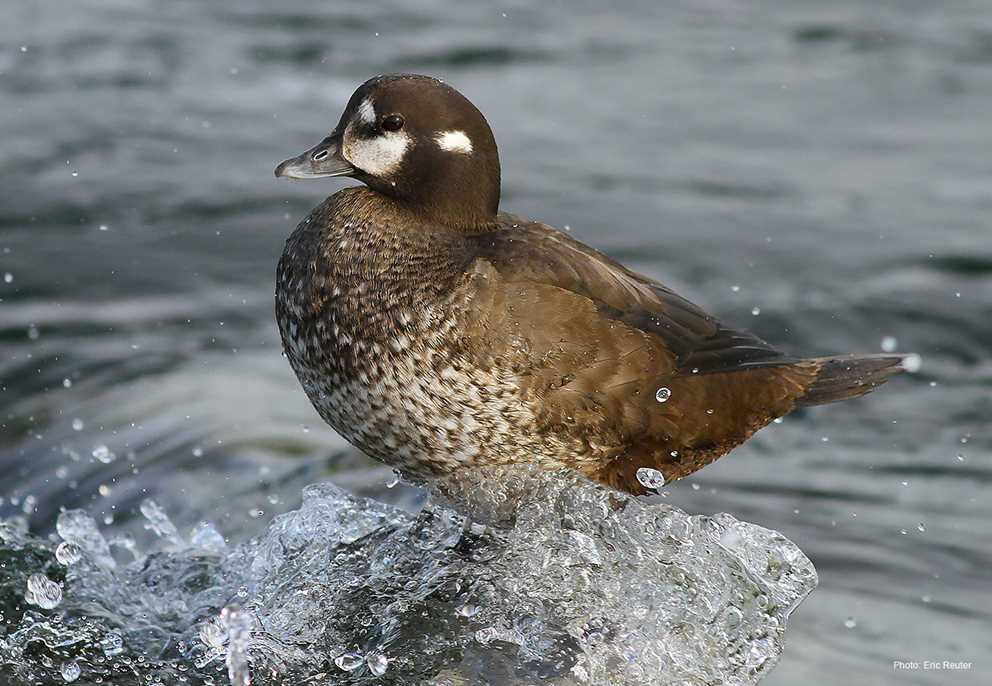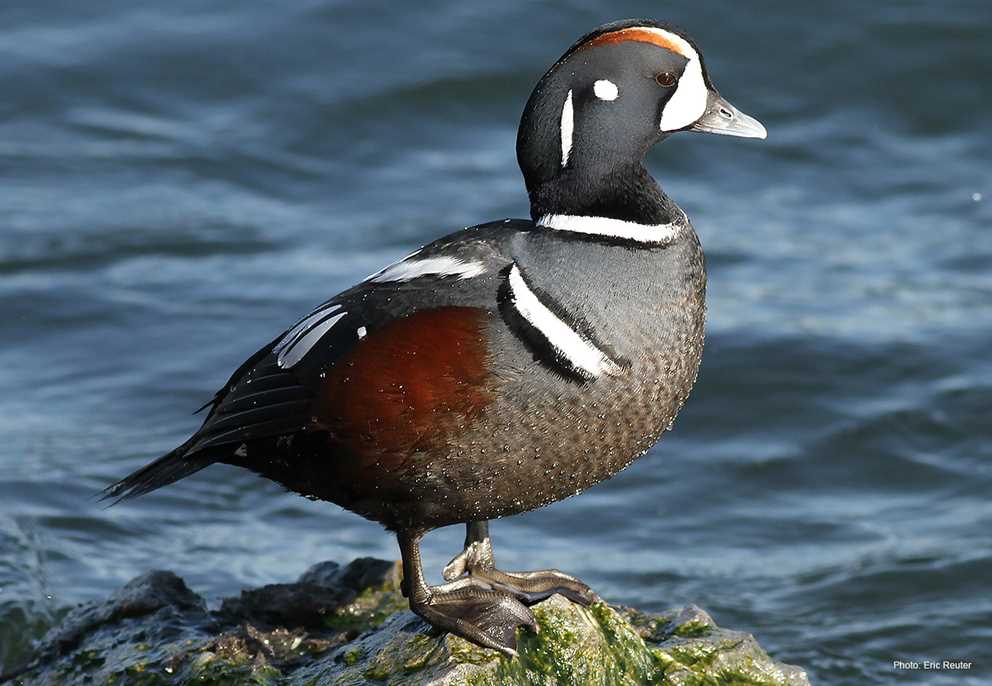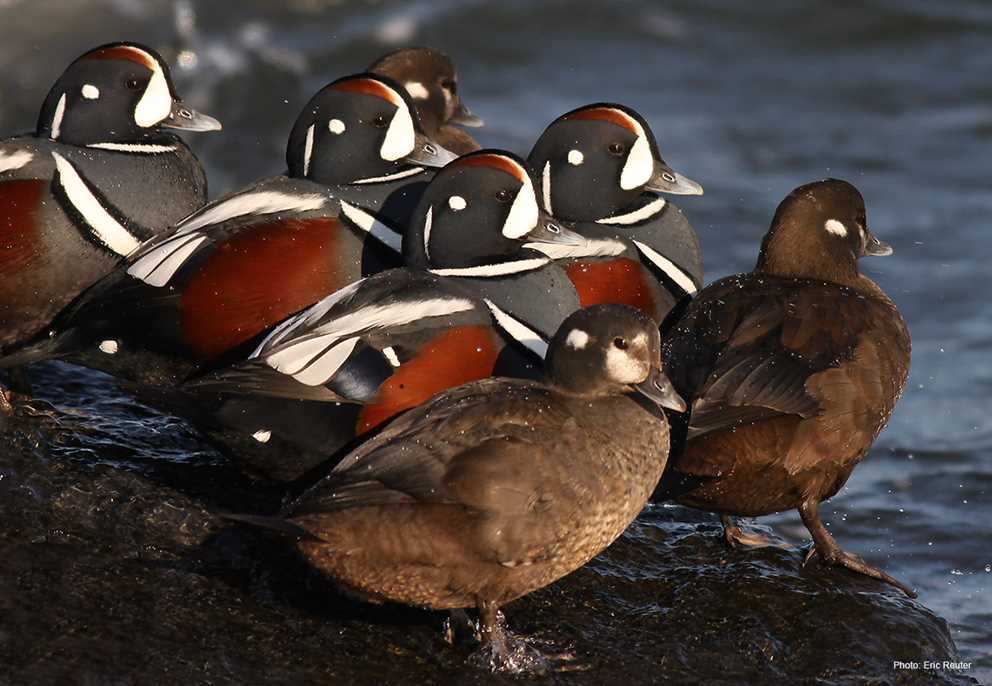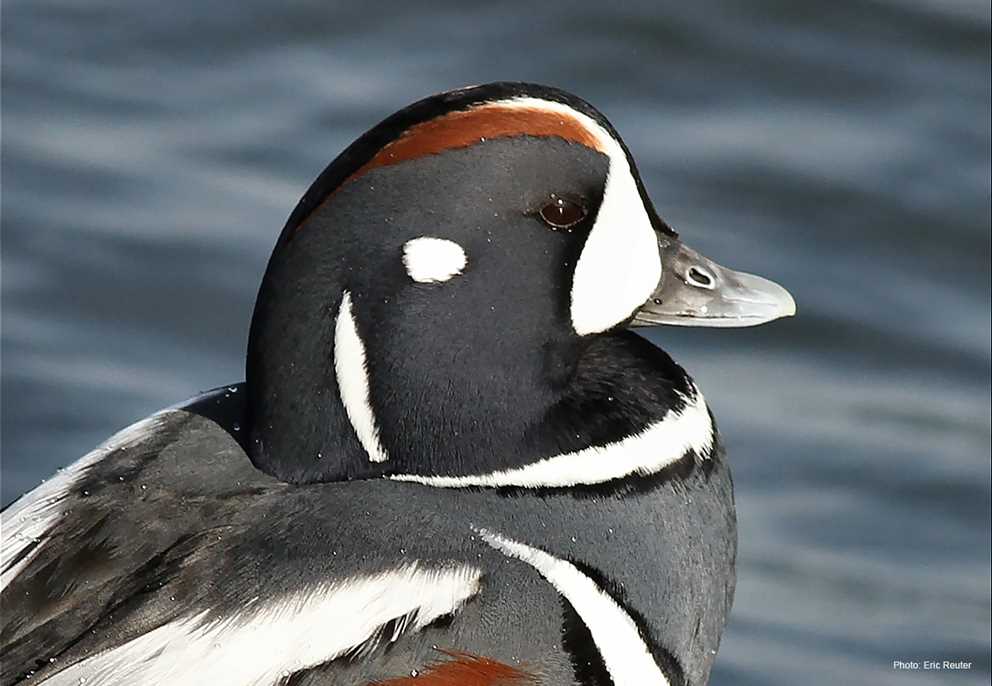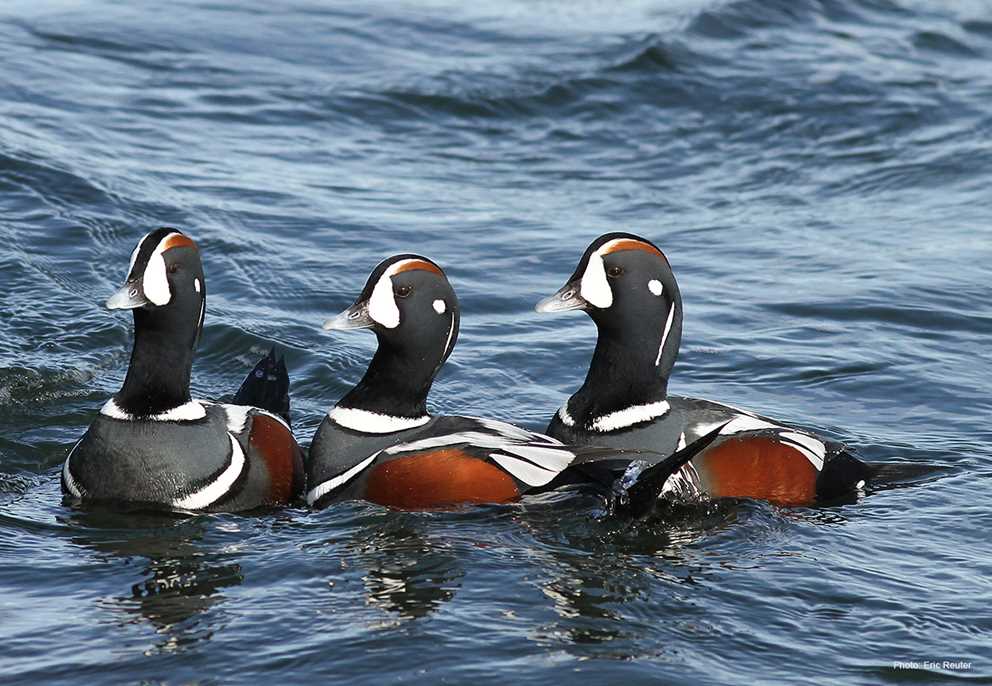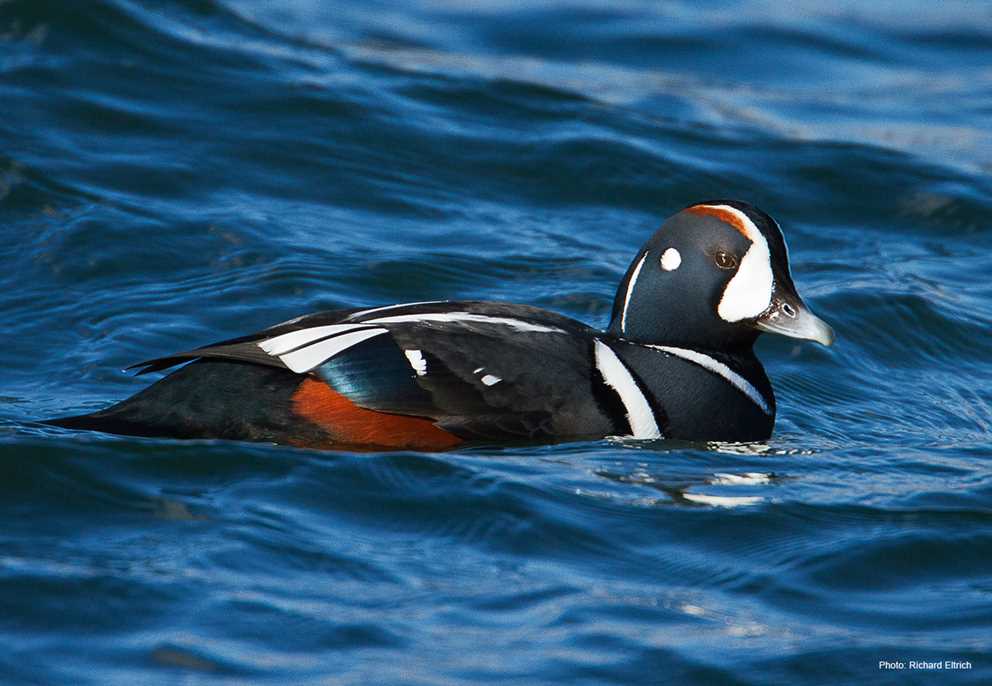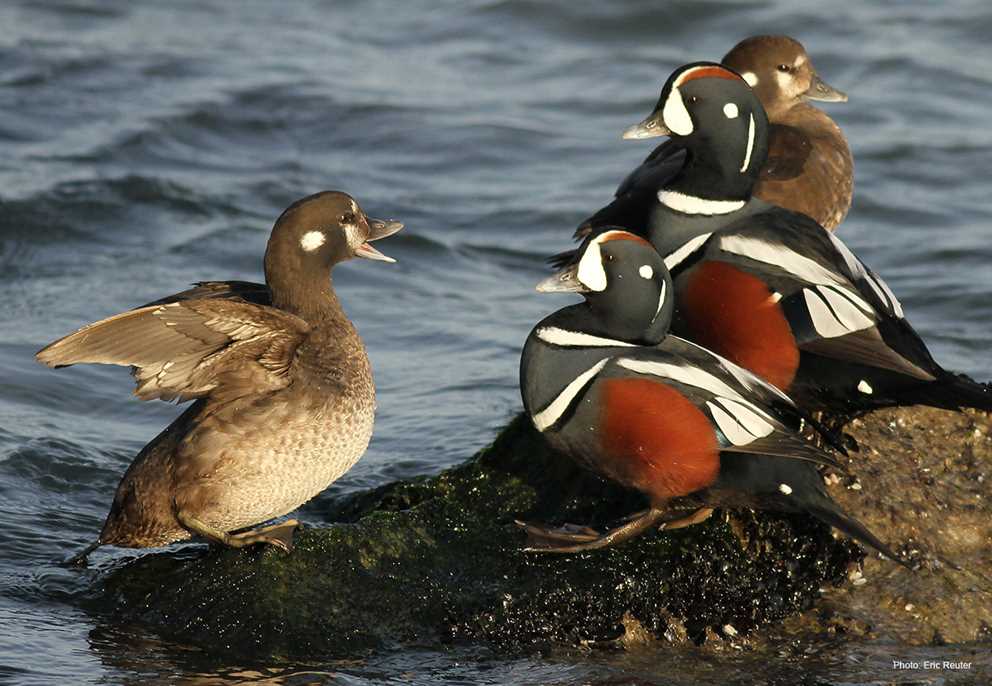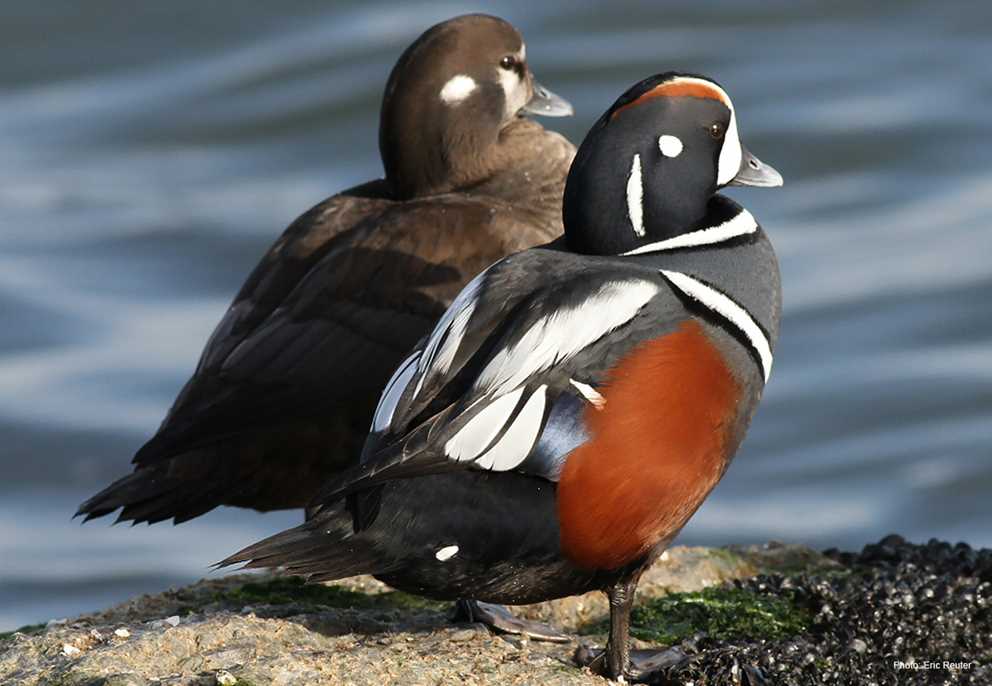Overview
The Harlequin Duck is the smallest of the sea ducks with a range including eastern Siberia, Greenland, Iceland, and North America. In North America, Harlequin Ducks have two disjunct breeding populations. The small Eastern Population breeds in maritime provinces of eastern Canada, while the Western Population breeds in mountainous areas of the Pacific Northwest, western Canada, and Alaska. They winter in rocky, intertidal areas of the northern Pacific from Alaska to northern California, and in the north Atlantic from Greenland to Chesapeake Bay.
Males in alternate plumage are unmistakable with a slate blue body bordered by black lines on the head and chest, a large white crescent in front of the eye, small white dot behind the eye, and a white vertical stripe on the side of the neck and shoulder. The flanks appear rich chestnut brown. Females and first winter juvenile males are brown with a white belly, have a white patch below and in front of the eye, and a white spot behind the eye towards the back of the head.
Breeding Harlequin Ducks typically use fast-flowing streams in riparian, sub-alpine or coastal areas. Streams are typically rocky, braided, and have gravel or sand bars for loafing. Often seen foraging for invertebrates in rapids or rocky stretches. In some areas they use lakes, offshore islands, or mainland coasts. Nonbreeding habitats are usually rocky shorelines of Greenland, the northern Pacific to California, and northern Atlantic to Chesapeake Bay. They feed heavily on mollusks and crustaceans.
Description
Key Identification Features
- Wings of both sexes appear gray or grayish-blue in flight.
- Males in alternate plumage are unmistakable with slate blue body, bordered by black lines on the head and chest, presence of a large white crescent in front of the eye, a small white dot behind the eye, and a white vertical stripe on the side of the neck or shoulder.
- Females and first winter juvenile males are slate brown overall with a brown head, and triangular white patch from below and forward of eye to bill, and another small round white dot behind the eye.
Male/Female Average Length and Weight
- Weight: Males 0.9–1.7 lbs.; Females 0.8–1.5 lbs.
- Wingspan: Males 6.2–8.5 in.; Females 5.7–8.3 in.
Male Identification
- Alternate (Breeding) Plumage: Males in alternate plumage are unmistakable with slate blue body, bordered by black lines on the head and chest, presence of a large white crescent in front of the eye,a small white dot behind the eye, and a white vertical stripe on the side of the neck or shoulder. The flanks appear rich chestnut brown. The bill is dark gray at the base and whitish-gray-blue towards the tip. The feet and legs are gray.
- Basic Plumage: Basic plumage of males is dark, with a gray or black head. The white patches on the head are retained.
Female Identification
- Alternate and Basic Plumage: Females are slate brown overall with a brown head, a triangular white patch from below and forward of eye to bill, and another small round white dot behind the eye. Alternate and basic plumages are similar.
In-Flight Identification
- Male: In flight, males show slate blue head and body with distinctive, crescent-shaped white patch in front of the eye, and a smaller round white spot behind the eye.
-
Female: Females are grayish brown, with three white markings on the head including a white patch below the eye to the base of the bill, a small white patch above and in front of the eye, and a small white round spot behind the eye.
Vocalizations
- Fairly vocal for a sea duck, making a mouse-like squeak “gia.”
Similar Species
- Adult male Harlequin Ducks in breeding (alternate) plumage are unique and unmistakable.
- Buffleheads: Females and immature males may be confused with female Buffleheads and scoters, but may be distinguished from Bufflehead by brown breast, white patch in front of eye, and lack of white patch/markings on wings.
- Scoters: Smaller than scoters, with a steeper forehead and smaller bill.
Habitat Preferences
- Breeding: Harlequin Ducks prefer fast-flowing, rocky streams during the breeding season, though some may occur on mountain lakes and rocky intertidal marine shorelines. Nests are usually on the ground, but may be on cliff ledges, in tree cavities or on stumps, always in association with small, fast-flowing streams.
- Migration and Wintering: In winter, they are mostly found in rocky intertidal and near-coastal waters.
Foraging Habits and Diet
- Harlequin Ducks forage extensively on invertebrates throughout the annual cycle. Amphipods, crabs, and mollusks make up a varied diet.
Breeding Habits
- Monogamy: Harlequin Ducks are considered monogamous. Pair bonds formed in winter, and some may last multiple seasons Most females do not nest until 3 years of age, though some 2-year-olds may breed. Most males do not breed until age 3, though some 2-year-old males may form pair bonds.
- Nest Locations: Females create a nest bowl, usually on the ground, under trees, in dense shrubs, or under fallen logs. Nests may be lined with conifer needles, mosses, leaf litter or pebbles, and are lined with down as laying progresses. Nests are located in close proximity to streams in riparian areas, islands, shorelines, or small cliff ledges.
- Clutch Size: Clutch size averages of 5–7 eggs. The eggs are sub-elliptical to elliptical, pale cream to pale buff, with size from 2.0–2.5 by 1.4–1.7 in. The incubation period averages 27–29 days.
Migration and Distribution
- Fall Migration: Male Harlequin ducks depart breeding areas for molting areas in late June or early July, while females and young birds depart in August or September. Arrival on migration and winter areas is variable but peaks in October and November.
- Spring Migration: Spring migration occurs March to May, but peaks in April. Birds begin arriving on breeding areas in May or early June depending on timing of ice breakup.

Conservation Status
- IUCN Status: Least Concern
- Population Status: There are no comprehensive estimates of population size for Harlequin Ducks because of the difficulty surveying areas used by the species. Estimates for the Western Population range from 150,000 to 250,000, of which perhaps 100,000 winters in the Aleutian Islands. The smaller Eastern Population is estimated to be between 1,800–2,000 birds in winter and remains a species of concern under the Endangered Species Act. Investment in population monitoring is needed for this species, as well as other sea ducks, to better understand population trends.
- Conservation Concerns: The primary threats include habitat loss, oil spills, and effects of climate change on preferred food resources.
- Conservation Focus: Conservation efforts include demographic studies, improved understanding of population status and trajectory, and protecting existing habitat.
Description
- An average of 1,258 birds were harvested per year from 1999–2008, with over 90 percent of the harvest occurring in Alaska.
- Harvest in the eastern portion of the Harlequin Duck’s range is prohibited.
- Harlequin Ducks are harvested at moderate to low levels for subsistence hunting in Alaska and Canada.
